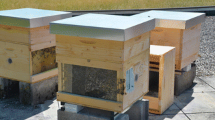Summary
Current ethograms for honeybee behavior are hypothesized to consist of age-related cohorts of workers having a high probability of performing a small set of related tasks in a restricted portion of the nest. Wax secretion and wax working related activities were assayed in this light. It is shown that wax secretion is significantly affected by worker age and that bees between 3 and 21 days old form such a cohort. Comb building festoons, previously thought to be the site of wax secretion, represent only a small fraction of newly secreted wax in the nest. Wax secretion remains constant relative to age in the cohort but varies significantly with season as does bee participation in festooning behavior. Wax secretion and wax working are both definable in terms of time and space in the nest, the relative probability of activity changing with season. Secretion itself is constrained by the cyclical activity of the underlying wax gland complex.
Similar content being viewed by others
References
Boehm B (1965) Beziehungen zwischen Fettkörper, Oenocyten und Wachsdrüsenentwicklung bei Apis mellifica L. Z Zellforsch Mikrosk Anat 65:74–115
Breed MD, Robinson GE, Page RE Jr (1990) Division of labor during honey bee colony defense. Behav Ecol Sociobiol 27:395–401
Crailsheim K, Stolberg E (1989) Influence of diet, age and colony condition upon intestinal proteolytic activity and size of the hypopharyngeal glands in the honeybee (Apis mellifera L.) J Insect Physiol 35: 595–602
da Cruz Landim C (1963) Evaluation of the wax and scent glands in the Apinae (Hymenoptera: Apidae). J NY Entomol Soc 21:2–13
Darchen R (1962) Observation directe du development d'un rayon de cire. Le rôle des chaînes d'abeilles. Insectes Soc 9:103–120
Dönhoff E (1855) Über das Herrschen verschiedener Triebe in verschiedenen Lebensaltern bei den Bienen. Schweiz Bienen-Ztg (cited from Ribbands 1953)
Dreyling L (1903) Über die wachsbereitenden Organe der Honigbiene. Zool Anz 26:710–715
Fergusson CA, Winston ML (1988) The influence of wax deprivation on temporal polyethism in honeybee (Apis mellifera L.) colonies. Can J Zool 66:1997–2001
Freudenstein H (1960) Einfluß der Pollennahrung auf das Bauvermögen, die Wachsdrüsen und den Fettkörper der Honigbiene (Apis mellifera L). Zool J Allg Zool Physiol Tiere 69:95–124
Goetze G, Bessling BK (1959) Die Wirkung verschiedener Fütterung der Honigbiene auf Wachserzeugung und Bautätigkeit. Z Bienenforsch 4:202–209
Hepburn HR (1986) Honeybees and wax. An experimental natural history. Springer, Berlin Heidelberg New York
Hepburn HR, Whiffler LA (1988) Dwarf and queenballs in swarms of the Cape honeybee. SA J Sci 84: 851–852
Hepburn HR, Bernard RTF, Davidson BC, Muller WJ, Lloyd P, Kurstjens SP, Vincent SL (1991) Synthesis and secretion of beeswax in honeybees. Apidologie 22:21–36
Huber F (1792) Nouvelles observations sur les abeilles. Barde, Mangel, Genève
King GE (1928) The larger glands in the worker honey-bee. A correlation of activity with age and with physiological functioning. PhD Thesis, University of Illinois
Kolmes SA (1985) An information-theory analysis of task specialization among worker honey bees performing hive duties. Anim Behav 33:181–187
Lau D (1959) Beobachtung und Experimente über die Entstehung der Bienenwabe (Apis mellifica L.). Zool Beitr 4:233–306
Lindauer M (1952) Ein Beitrag zur Frage der Arbeitsteilung im Bienenstaat. Z Vergl Physiol 34:299–345
Lineburg B (1923) What do bees do with brood cappings? Am Bee J 63: 235–236
Liu TP (1989) Juvenile hormone III induced ultrastructural changes in the hypopharyngeal glands of honeybee Apis mellifera L. (Hymenoptera: Apidae) without and with infection by Nosema apis Zander (Microsporidae: Nosematidae). Int J Insect Morphol Embryol 18:73–83
Meyer W (1952) Die Kleinbauarbeiten unserer Bienen. Dtsch Bienenwirtsch 3:237
Meyer W (1954) Beobachtung und Versuche über den Transport und die Verwendung von dargebotenem Wachs bei der Honigbiene. Z Bienenforsch 2:147–157
Ribbands CR (1953) The behaviour and social life of honeybees. Bee Research Association, London
Rösch GA (1925) Untersuchungen über die Arbeitsteilung im Bienenstaat. I. Die Tätigkeiten im normalen Bienenstaate und ihre Beziehungen zum Alter der Arbeitsbienen. Z Vergl Physiol 2:571–631
Rösch GA (1927) Über die Bautätigkeit im Bienenvolk und das Alter der Baubienen. Weiterer Beitrag zur Frage nach der Arbeitsteilung im Bienenstaat. Z Vergl Physiol 6:265–298
Schulze BR (1965) Climate of South Africa. No. 8 Weather Bureau, Department of Transport, Pretoria
Seeley TD (1982) Adaptive significance of the age polyethism schedule in honeybee colonies. Behav Ecol Sociobiol 11:287–293
Seeley TD (1985) Honeybee ecology. A study of adaptation in social life. Princeton University Press, Princeton
Smith MV (1959) A note on the capping activities of an individual honeybee. Bee World 40:153–154
Turrell MJ (1972) An investigation of the factors influencing the development of the wax glands in the honey bee, Apis mellifera L. MS Thesis, Cornell University
Whiffler LA, Drusedau MUH, Crewe RM, Hepburn HR (1988) Defensive behaviour and the division of labour in the African honeybee (Apis mellifera scutellata). J Comp Physiol A 163:401–411
Whiffler L, Hepburn HR (1991) The queen in relation to wax secretion and comb building in honeybees. J Comp Physiol A 169:209–214
Winston ML (1987) The biology of the honey bee. Harvard Press, Cambridge
Author information
Authors and Affiliations
Rights and permissions
About this article
Cite this article
Muller, W.J., Hepburn, H.R. Temporal and spatial patterns of wax secretion and related behavior in the division of labour of the honeybee (Apis mellifera capensis). J Comp Physiol A 171, 111–115 (1992). https://doi.org/10.1007/BF00195966
Accepted:
Issue Date:
DOI: https://doi.org/10.1007/BF00195966




